英语词汇课教案全英文
高中英语词汇课教案
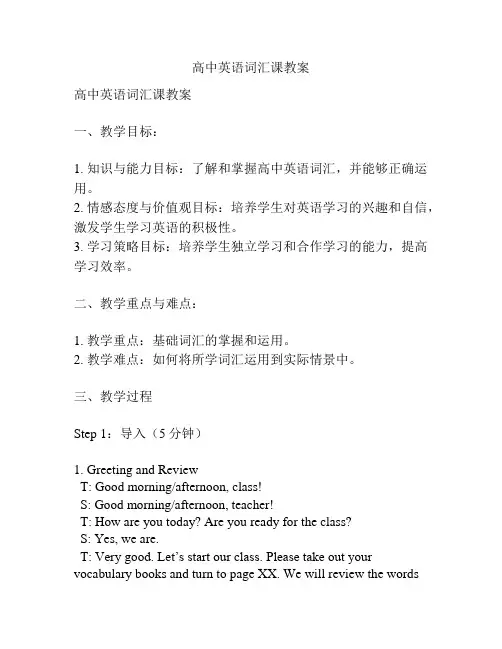
高中英语词汇课教案高中英语词汇课教案一、教学目标:1. 知识与能力目标:了解和掌握高中英语词汇,并能够正确运用。
2. 情感态度与价值观目标:培养学生对英语学习的兴趣和自信,激发学生学习英语的积极性。
3. 学习策略目标:培养学生独立学习和合作学习的能力,提高学习效率。
二、教学重点与难点:1. 教学重点:基础词汇的掌握和运用。
2. 教学难点:如何将所学词汇运用到实际情景中。
三、教学过程Step 1:导入(5分钟)1. Greeting and ReviewT: Good morning/afternoon, class!S: Good morning/afternoon, teacher!T: How are you today? Are you ready for the class?S: Yes, we are.T: Very good. Let’s start our class. Please take out your vocabulary books and turn to page XX. We will review the wordswe learned last time. Please read them out aloud one by one.2. Review the vocabularyT: Great job! Now let’s review the words together. (Teacher and students read the words together.)Step 2:新词学习与运用(20分钟)1. Introduce new wordsT: Now l et’s move on to our new words today. The first word is “advantage” which means a beneficial or helpful factor or circumstance.(Teacher writes the word on the blackboard or shows the flashcard.)Now let’s repeat after me. “advantage”.S: “advantage”.T: Very good. The second word is “disadvantage” which means an unfavorable or harmful factor or circumstance.(Teacher writes the word on the blackboard or shows the flashcard.)Now let’s repeat after me. “disadvantage”.S: “disadvantage”.2. Vocabulary practiceT: Now let’s practice the new words. I will give you some sentences. Please fill in the blanks with the correct forms of the new words.(Teacher writes the sentences on the blackboard.)Example: She took advantage of the opportunity to study abroad.1. One of the disadvantages of living in a big city is the highcost of living.2. The team has a clear advantage over their rivals.3. He used his knowledge to his disadvantage.(Students work in pairs or groups to complete the sentences.) Step 3:巩固和拓展(15分钟)1. Vocabulary quizT: Now let’s have a vocabulary quiz. I will give you a word and you need to tell me the meaning of it.(Teacher calls on individual students to answer the questions.) 2. Vocabulary gameT: It’s time for a vocabulary game. I will divide the class into two teams. Each team will take turns to give a sentence using the new words we learned today. The sentence should be related to a specific topic. The team that can give the most sentences wins.(Teacher divides the class into two teams and sets a topic for the game.)Example: Topic: SportsTeam A: She took advantage of the good weather to go for a run. Team B: One of the disadvantages of playing basketball is the risk of injury.(Teams take turns to give sentences until one team cannot come up with a sentence.)Step 4:小结与作业布置(10分钟)1. SummaryT: It’s time to summarize what we have learned today. Welearned two new words today: “advantage” and “disadvantage”. Can you give me the definitions of them?S: “advantage” means a beneficial or helpful factor or circumstance, and “disadvantage” means an unfavorable or harmful factor or circumstance.T: Very good. Now let’s review the sentences we practiced toda y. Can you give me some examples?S: (Students give examples of sentences using the new words.) 2. HomeworkT: Your homework for today is to write a short paragraph about the advantages and disadvantages of living in a big city. You can use the vocabulary we learned in class today. The paragraph should have at least 5 sentences.(Teacher writes the homework assignment on the blackboard.) Step 5:教学反思(5分钟)本节课主要是进行词汇学习和运用。
四年级下册英语词汇课教案5篇

四年级下册英语词汇课教案5篇四年级下册英语词汇课教案5篇教案是教师为顺利而有效地开展教学活动,根据课程标准,教学大纲和教科书要求及学生的实际情况,以课时或课题为单位,对教学内容、教学步骤、教学方法等进行的具体设计和安排的一种实用性教学文书。
以下是带来的四年级下册英语词汇课教案内容,感谢您的阅读,希望能帮助到您!四年级下册英语词汇课教案1教学目标:(一)语言知识目标1、通过以旧引新、借助图片的形式,90%的学生对本单元的3个重点单词capital about beautiful 熟练地认读,做到听、说、读、写四会。
2、能在问题的引领下,80%的学生通过小组合作,在文中找出问题的答案。
能在老师的帮助下,90%的学生理解领悟London is the capitalof England . It’s very ______ and _______. Is that your house ? Yes ,it is ./ No,it isn’t .等句型。
(二)语言技能目标1、学生能借助图片,以及关键词的提示,通过听说交流活动运用所学习到的句型进行介绍城市,描述建筑物。
2、学生能借助于图片、关键词及老师、同伴的提示,对文本内容作出简单的没有认读错误的复述。
3、学生能在老师创设的情景中,对自己熟悉的环境进行简单的交流。
(三)情感态度目标1、学生在同桌合作学习中,根据拼读规律大声快速地读出单词。
2、在小组活动中,与其他同学积极配合,进行问题研究及合作交流。
3、在学习中乐于接触外国文化,知道英国国家的首都,增强祖国意识。
(四)学习策略目标1、学生通过比赛游戏,积极与他人合作,共同完成学习任务。
2、学生能在看图、说话的过程中提高自己的口语交际水平,以及与他人合作的能力。
(五)文化意识目标1、通过文本的学习,能说出英语的首都,了解了英国的重要建筑物。
2、在学习中关注中外文化的差异,在学习中增强爱国情感的体验。
(六)教学重点1、单词capital about beautiful 达到四会。
英语词汇课教案
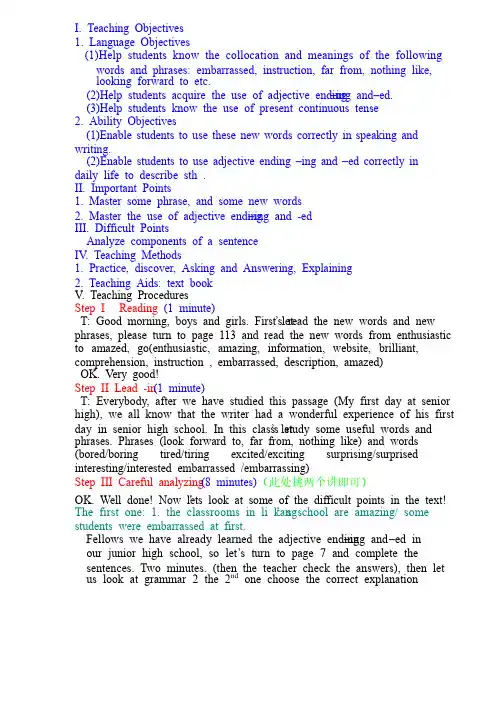
I. Teaching Objectives 1. Language Objectives (1)Help students know the collocation and meanings of the following words and phrases: embarrassed, instruction, far from, nothing like, looking forward to etc. (2)Help students acquire the use of adjective ending –ing and –ed. (3)Help students know the use of present continuous tense 2. Ability Objectives (1)Enable students to use these new words correctly in speaking and writing. (2)Enable students to use adjective ending –ing and –ed correctly in daily life to describe sth . II. Important Points 1. Master some phrase, and some new words 2. Master the use of adjective ending –ing and -ed III. Difficult Points Analyze components of a sentence IV . Teaching Methods 1. Practice, discover, Asking and Answering, Explaining 2. Teaching Aids: text book V . Teaching ProceduresStep I Reading (1 minute) T: Good morning, boys and girls. First let ’s read the new words and new phrases, please turn to page 113 and read the new words from enthusiastic to amazed, go(enthusiastic, amazing, information, website, brilliant, comprehension, instruction , embarrassed, description, amazed) OK. V ery good! Step II Lead -in (1 minute) T: Everybody, after we have studied this passage (My first day at senior high), we all know that the writer had a wonderful experience of his first day in senior high school. In this class let ’s study some useful words and phrases. phrases. Phrases Phrases Phrases (look (look (look forward forward forward to, to, to, far far far from, from, from, nothing nothing nothing like) like) like) and and and words words (bored/boring tired/tiring excited/exciting surprising/surprised interesting/interested embarrassed /embarrassing) Step III Careful analyzing (8 minutes) (此处挑两个讲即可)(此处挑两个讲即可)OK. Well done! Now let ’s look at some of the difficult points in the text! The first one: 1. the classrooms in li kang ’s school are amazing/ some students were embarrassed at first. Fellows we have already learned the adjective ending –ing and –ed in our our junior junior junior high high high school, school, school, so so so let let let’’s s turn turn turn to to to page page page 7 7 7 and and and complete complete complete the the sentences. Two minutes. (then the teacher check the answers), then let us us look look look at at at grammar grammar grammar 2 2 2 the the the 22nd one one choose choose choose the the the correct correct correct explanation explanation according to the exerxise we have done in page 7. ok it seems that you have have a a a clear clear clear mind mind mind of of of the the the 2 2 2 kinds kinds kinds of of of endings, endings, endings, so so so let let let us us us find find find more more examples in our text.(2nd paragraph, the classrooms are amazing, the3rd I don ’t think I will be bored in Ms Shen ’s class, the 4th paragraph some students were embarrassed at first) The next one. 2…and Ms Shen’s method of teaching is nothing like that of the teachers at my Junior High school.(the sentence under the picture ) Nothing like means , “丝毫不象”in chinese 。
小学英语词汇课全英文教案模板
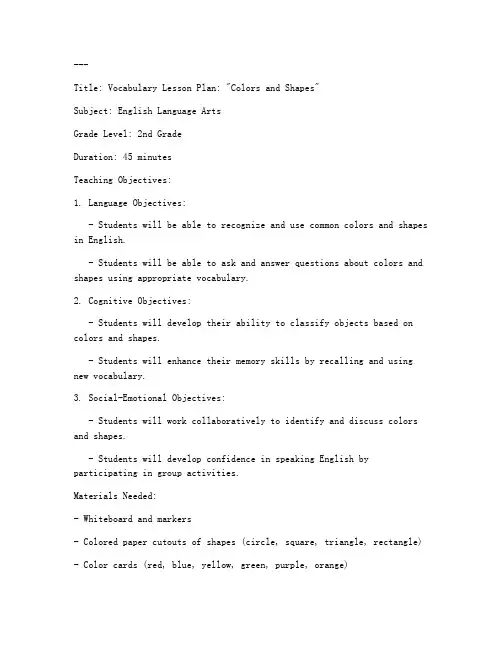
---Title: Vocabulary Lesson Plan: "Colors and Shapes"Subject: English Language ArtsGrade Level: 2nd GradeDuration: 45 minutesTeaching Objectives:1. Language Objectives:- Students will be able to recognize and use common colors and shapes in English.- Students will be able to ask and answer questions about colors and shapes using appropriate vocabulary.2. Cognitive Objectives:- Students will develop their ability to classify objects based on colors and shapes.- Students will enhance their memory skills by recalling and using new vocabulary.3. Social-Emotional Objectives:- Students will work collaboratively to identify and discuss colors and shapes.- Students will develop confidence in speaking English by participating in group activities.Materials Needed:- Whiteboard and markers- Colored paper cutouts of shapes (circle, square, triangle, rectangle)- Color cards (red, blue, yellow, green, purple, orange)- Vocabulary cards with pictures of objects (car, ball, apple, house, sun)- flashcards with words and pictures- worksheets for practice activitiesTeaching Procedure:1. Warm-Up (5 minutes):- Greet students with a "Good morning/afternoon" and ask them to share what they did over the weekend.- Use a simple question such as "What did you do yesterday?" to practice the present simple tense.2. Introduction to New Vocabulary (10 minutes):- Begin by introducing the theme of the lesson: "Colors and Shapes."- Show the students the color cards and ask them to identify each color.- Point to each shape cutout and ask the students to name it.3. Vocabulary Practice (15 minutes):- Distribute vocabulary cards with pictures and words.- Ask students to match the pictures with the correct words.- Use the flashcards to review the words and encourage students to say them aloud.4. Group Activity: Color and Shape Sorting (10 minutes):- Divide the class into small groups.- Give each group a set of color and shape cutouts.- Instruct the students to sort the cutouts according to color and shape.- Each group will present their sorted items to the class.5. Interactive Activity: "Find the Item" (10 minutes):- Place the worksheets with pictures of items in different colors and shapes around the classroom.- Instruct the students to find and circle the items that match the target vocabulary.- After they have completed the task, review the answers as a class.6. Wrap-Up (5 minutes):- Conclude the lesson by reviewing the key vocabulary: colors (red, blue, yellow, green, purple, orange) and shapes (circle, square, triangle, rectangle).- Ask students to create a simple drawing using different colors and shapes.- Encourage them to describe their drawings using the new vocabulary.Assessment:- Observe students' participation in activities and their ability to use the target vocabulary correctly.- Check the completed worksheets to assess their understanding of the new vocabulary.- Hold a short quiz at the end of the lesson to test their recall of the colors and shapes.---Note: This template can be adapted to include other themes or specific vocabulary lists. Adjust the activities and materials according to the needs and abilities of your students.。
幼儿园中班英语词汇教案五篇
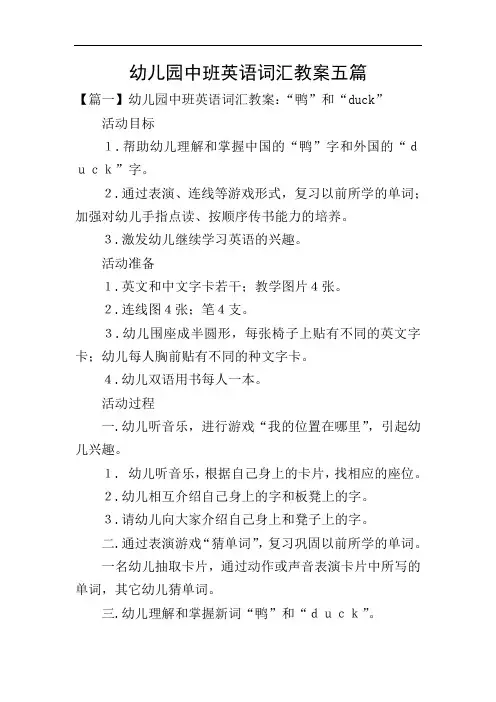
幼儿园中班英语词汇教案五篇【篇一】幼儿园中班英语词汇教案:“鸭”和“duck”活动目标1.帮助幼儿理解和掌握中国的“鸭”字和外国的“duck”字。
2.通过表演、连线等游戏形式,复习以前所学的单词;加强对幼儿手指点读、按顺序传书能力的培养。
3.激发幼儿继续学习英语的兴趣。
活动准备1.英文和中文字卡若干;教学图片4张。
2.连线图4张;笔4支。
3.幼儿围座成半圆形,每张椅子上贴有不同的英文字卡;幼儿每人胸前贴有不同的种文字卡。
4.幼儿双语用书每人一本。
活动过程一.幼儿听音乐,进行游戏“我的位置在哪里”,引起幼儿兴趣。
1. 幼儿听音乐,根据自己身上的卡片,找相应的座位。
2.幼儿相互介绍自己身上的字和板凳上的字。
3.请幼儿向大家介绍自己身上和凳子上的字。
二.通过表演游戏“猜单词”,复习巩固以前所学的单词。
一名幼儿抽取卡片,通过动作或声音表演卡片中所写的单词,其它幼儿猜单词。
三.幼儿理解和掌握新词“鸭”和“duck”。
1.教师出示图片,介绍鸭宝宝;帮助幼儿认识中国的“鸭”字和外国的“duck”字并讲述故事。
2.通过提问的方式帮助幼儿熟悉中国的“鸭”字和外国的“duck”字。
3.幼儿与教师共同扮演鸭宝宝,引导幼儿理解中国的“鸭”字和外国的“duck”字。
4.幼儿找出图片中,中国的“鸭”字和外国的“duck”字。
5.教师手指中国的“鸭”字或外国的“duck”字,请幼儿用不同速度的鸭子走的动作来区别它们。
6.请幼儿找出黑板上的中国的“鸭”字和外国的“duck”字和他们一起做游戏。
7.引导幼儿认识外国的“duck”字(1)引导幼儿看图片,讨论外国的鸭字里有哪些字母,并启发幼儿做出动作。
(2)教师边讲故事边表演,引导幼儿观看,并告诉幼儿,各个字母逐个点合成为外国的“duck”。
(3)引导幼儿扮演字母,表演故事。
四.引导幼儿看书,进一步认识中国的“鸭”字和外国的“duck”字。
1.引导幼儿传书,发展幼儿的良好的行为习惯。
9.小学英语教师面试:词汇课《My schoolbag》全英文教案及试讲逐字稿
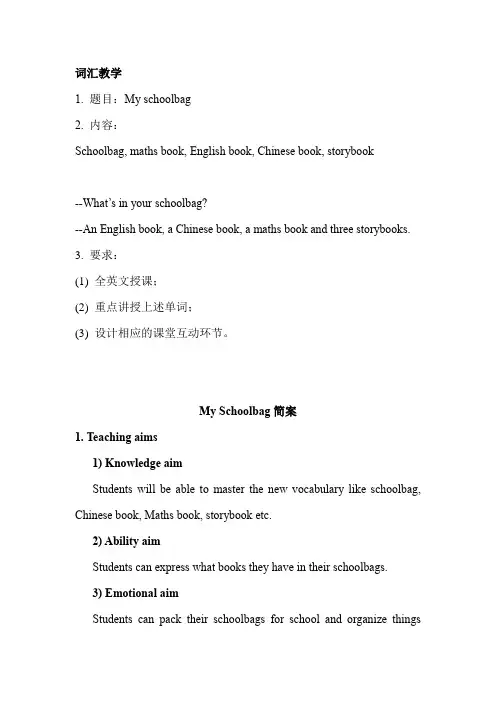
词汇教学1. 题目:My schoolbag2. 内容:Schoolbag, maths book, English book, Chinese book, storybook--What’s in your schoolbag?--An English book, a Chinese book, a maths book and three storybooks. 3. 要求:(1) 全英文授课;(2) 重点讲授上述单词;(3) 设计相应的课堂互动环节。
My Schoolbag简案1. Teaching aims1) Knowledge aimStudents will be able to master the new vocabulary like schoolbag, Chinese book, Maths book, storybook etc.2) Ability aimStudents can express what books they have in their schoolbags.3) Emotional aimStudents can pack their schoolbags for school and organize thingsorderly.2. Important and difficult points1) Important pointStudents can describe what books they have in their schoolbags and ask their partners what they have in their schoolbags.2) Difficult pointStudents will improve their speaking skill and communicate with each other freely.3. Teaching and learning methodsSituational teaching method; communicative teaching method; task-based teaching method; cooperation study method; independent study method4. Teaching proceduresStep 1: Warming upI will share a story with the students, and lead in the topic “storybooks”.Step 2: Presentation1) Presenting new words. I will bring with a handbag and let the students touch the bag, and then guess what I have in my bag. In this way, new words like Chinese book, English book, Maths book and storybooks are shown to the students.2) Listen to a song “My schoolbag”. We will sing together. And thengirls and boys take turns to sing the song.Step 3: Practice1) Listen and tick. Students will listen to the tape and tick the pictures they heard in the dialogue.2) Play a game. We will play a game named “high and low voice”. Students will practice their pronunciation by playing the game.Step 4: Production1) Pair work: Make a new dialogue. Students will make a new dialogue by using the vocabulary we’ve learned today.2) Group work: Help Li Hua out. A situation is created to let the students put what they have learned into practice.Step 5: Summary and homeworkTeacher leads students to summarize what they have learned in this class.Homework:Task1: Finish the exercises in your workbook;Task 2: Sing the song to your parents.5. Blackboard designMy SchoolbagWhat do you have in your schoolbag?an English book/a Chinese book/ a Maths book/ three storybooks试讲稿:My SchoolbagWarming up:Hello, boys and girls. Welcome to English class. I’m telling you a story: Mr. Li is a good painter. One day he draws a beautiful dragon without eyes. Mr. Zhou looks at the picture and says, “The dragon has no eyes. It isn’t a good picture.” But Mr. Li smiles and says, “If I add eyes to the dragon, it will fly away.” Mr. Zhou shakes head and says, “You are boasting. I don’t believe you.” Mr. Li isn’t angry. He holds the paintbrush and adds eyes to the dragon. Woe! The dragon really flies. That is the story “Adding eyes to a dragon”. This idiom is used to describe one who brings out the crucial point in writing. Do you like the story? Yes. This is my storybook. I will put it into my handbag.PresentationBoys and girls, look at my handbag. It’s bulging. Can you guess what I have in my bag? Touch it and guess. Storybooks? Yes. Do you know how many storybooks I have? Aha, I have three storybooks. Touch my bag and guess what else are in my bag? A ball? A bottle? I will show you what I have in my bag: an English book/ a smart phone/an apple/a notebook/a pen...Teacher: You are so smart. The storybooks will be the prizes for today’s winners.Are you ready for today’s class? Great. Now, let’s look at today’s timetable. How many lessons will you have? 6…What are they? Now we。
高中英语《必修五第一单元单元词汇课》优质课教案、教学设计
教案设计(Learning about Language)部分由“词汇学习”和“语法学习”两项内容组成。
“词汇学习” 部分练习1 通过词的后缀训练名词与形容词之间的相互转换提倡学生使用词典。
练习2 选词填空练习,利用语篇集中训练本单元的一些重点词汇的用法。
练习3 是单句填空,而且所选的十个句子或是引文或是谚语。
“语法学习”部分主要是帮助学生了解、熟悉并掌握情态动词的用法,共有三项练习。
“语言运用”(Using Language)部分主要是让学生运用本单元所学的语言知识与课文内容进行听、说、读、写等的综合训练。
“听与说” (Listening and speaking); 是听前准备活动。
“读与写”(Reading and writing)主要设计是:阅读内容主要讲述一位来自高中的学生对全球变暖十分关注并向地球保护协会写了一封信询问措施。
协会给出了相当令人满意的回信。
短文后的三个问题帮助学生理解文章的内容。
写信的部分主要是要求学生根据上面阅读文章的内容通过思考写出自己的思想、自己的做法,尝试解决问题的不同途径。
教材提供给学生一些写作时要思考的问题,帮助学生完成写作构思。
“小结”(S ummin g U p)部分让学生根据所给出的提示对所学各项内容进行总结。
“学习建议”(L e a r nin g T ip)部分主要建议学生看阅读报纸,多读书多总结,以培养学生运用语言资源的能力。
五、教学重点Teaching important pointsa.The usage of language points of this unit.b.To learn to use these words.教学难点Teaching difficult pointsa.Enable students to get the hang of the language points completely.b.Get students to discuss warmly and express their own and excellent idea.教学方法Teaching methodsa.Brainstormingb.Task based language teaching.c.Individual, pair or group work to finish each task.d.Discussion.教学过程:1.concludevi.推断出vt.结束①conclude 推断出;断定conclude...with... 以...结束conclusion n .结论;结束arrive at/come to/reach/draw a conclusion 得出结论in conclusion 总而言之学生去说;学生能做的教师就不要代替学生去做;学生回答问题无论对还是错,教师不要急于评判,让学生自已去评判与总结;对发言积极的学生要及时鼓励,决不能因为他们的答案与教师的标准答案不一样就否定并伤害学生的自尊心。
4.小学英语教师面试:词汇课《What would you like to eat》 全英文教案及试讲逐字稿
题目:What would you like to eat?内容:词汇:Ice-cream, tea, hamburger, sandwich, salad.句型:-- What would you like to eat?-- I’d like a sandwich, please.1.基本要求:(1)全英文授课;(2)上词汇课,重点讲授:ice-cream, tea, hamburger, sandwich, salad;(3)要设计相应的课堂互动环节;教案:What would you like to eat?1.Teaching aims1)Knowledge aim: know the meaning of the new words.2)Ability aim: Use the new words in a correct way3)Emotional aim: Form a good sense of eating habit.2.Teaching key and difficult point1)Key point: apply the new words:Ice-cream, tea, hamburger, sandwich, salad.2)Difficult point: put the words into use in a real situation3.Teaching and learning methodTask-based language teaching method; Group work leaning method; Situated language method4.Teaching proceduresStep1: Warming-upChant with studentsStep2: Lead-inSet a situation: Peppa’s birthday. Lead to the topic: Food;Step3: Presentation1)Use the pictures to teach the new words: Ice-cream, tea, hamburger, sandwich, salad.2)Teach the new sentence patternsStep4: Practice1)Magic fingers. Read for many times2)Dice to dice: make conversationStep5: ProductionUse the words in a real situation.Step6 Summary and HomeworkSummarize the whole classDo a survey about what’s your parents’ favorite food, share next class5.Blackboard designWhat would you like to eat?Ice-cream, tea, hamburger, sandwich, salad.-- What would you like to eat?-- I’d like a sandwich, please.试讲稿:What would you like to eat?Warming-upGood morning boys and girls, class begins. Welcome to my lesson, I see the happy smile on your face. Wow, you are so excited now, let’s chant together before we start our lesson. Show me your hands and chant with me. One two three go!Apple red, apple round apple juice apple sweet, apple apple I love it, apple sweet I love it.Good voice! Good pronunciation!Ok, it’s time to start our lesson.Lead-inNow, here, I prepare a video for you. Please look at the PPT, who is she? Yeah! She is peppa! Great! You all like this cartoon right! Well, please tell me what are they doing? I heard most of you said they are having a birthday party at Susi sheep’s home. Well, this time, please watch the video carefully. What other things can you see. Great! I heard most of you said some salad, fruits and delicious food. Great! Here, wecan see Peppa and her friends are enjoying the delicious food. What do you want to have in your birthday party? Ice-cream? Hamburger? Well, Today our topic is food.PresentationHere are some pictures for about food, do you know it? Let’s see them together. How about this one? Great! You get it! That’s a big hamburger! If we are hungry, hamburger is a kind of delicious food. But it’s one of junk food, so we can’t eat it too much. Here are another kind of bread, that’s ... great sandwich!How about this time, there are so many different kinds of fruits and vegetables.Great! That’s salad.Well, this time, listen carefully, please guess, what’s this. I like to eat in summer when I feel hot! Quick reaction! I heard Lisa is the fastest. That’s ice-cream! Well, read after me, ice-cream, ice-cream.When I feel hot, I really want a cup of ... water? Coffee? Exactly, I want tea! Here, this is tea, read after me, tea, tea.Good job guys! That’s all for the new words.Well, please imagine that if you are going to have a birthday party and you are going to invite some friends to your home. You need to prepare the dinner for them. Then, how can you ask what they want to eat? Please think about it!Oh, some of you say we can say what do you want to eat? Em.. Ithink we need to be more polite. We can say, what would you like to eat. Read after me. What would you like to eat.How about the answer? Great! We can say, I’d like to...PracticeThis time, we will play a game named lucky card. Here are so many cards on my hand, I will choose it at random, if I show you 1 finger, you need to read it for 1 time, if 2, you need to read 2times. Clear? Let’s try! Please listen carefully!How about... this one! Exactly! That’s ice-cream!How about ... Great! Hamburger, read after me again!Well done guys! You are so quick minded!Here, I bring a new thing to you, please look at me, what’s this? It’s a dice! Great! If I throw the dice, you should use the word in the first side to make a new conversation with your partner. Let’s see whether you can use the sentence patterns correctly. Let’s go!One...Two...Three!Great! Who can try? I see all of you raise your hands high! Let me see. Oh, the boy in corner, you are so active this class. So, you and your desk mate come here and try. Let’s clap for them!Good job right? How many words can they use? They use hamburger, ice-cream, and also, they think they are in the supermarket. Great! I thinkyou will be an excellent actor in the future!Let’s move on!ProductionThis time, I will set a situation for you. Please imagine that you are in Walmart with your parents. Then, you need to choose what you are going to buy in the supermarket, because you are going to hold a birthday party. You need to do a survey in group and ask what they want to have in the party, then, you can buy. Later, some of you are invited to share in front of the class. 10 mins for you. Ready? Go!Ok, I need the brave volunteer! Mike and Amy, you two please! Other students, you need to listen carefully, and think about what they want to buy, how many kinds of food they buy in the supermarket. Ok, Mike and Amy, it’s your show time.Wow, let’s clap for them! Good performance! No mistakes, wonderful pronunciation and vivid expression right? How many kinds of food do they what to buy? Exactly, you are careful. Salad, ice-cream and hamburger. You are as good as gold! Well, I hope more students can be brave next time to show yourself in front of the class.SummaryHow time flies! Let’s conclude the whole class today. That’s a lesson about word. We learn ... ok, the words are on the blackboard. And the expression. Hope you can put them into use in your daily life.HomeworkHomework here for you. You need to find out what your parents want to eat in their birthday and share next class.Well, class is over bye byeThat’s all for my presentation, thanks for your listening。
初中英语全英文教案How do you make a banana milk shake
How do you make a banana milk shake?一、教学目标:1. 知识目标:学生能够掌握制作香蕉奶昔的步骤和关键词汇。
学生能够用英语进行简单的日常交流。
2. 技能目标:学生能够听懂并能够用英语复述制作香蕉奶昔的步骤。
学生能够在小组合作中运用英语进行交流和讨论。
3. 情感目标:学生能够培养对英语学习的兴趣和热情。
学生能够培养团队合作意识和积极参与精神。
二、教学内容:1. 主题:制作香蕉奶昔2. 关键词汇:banana, milk, shake, cut, blend, pour, mix3. 句型:How do you make a banana milk shake? What do you need?What step is it?Can you show me?三、教学过程:1. 导入:教师通过提问学生喜欢的饮品引入本课主题。
2. 呈现:教师展示一张香蕉奶昔的图片,引导学生说出banana milk shake。
教师通过动作和描述呈现制作香蕉奶昔的步骤。
3. 实践:学生分组,每组用英语讨论并写出制作香蕉奶昔的步骤。
每组选一名代表进行演示,并用英语解释每个步骤。
4. 巩固:教师组织学生进行角色扮演,模拟制作香蕉奶昔的场景。
学生用英语进行交流,巩固所学内容。
四、作业:1. 学生用英语写出制作香蕉奶昔的步骤,并画出相应的图片。
2. 学生回家后尝试制作香蕉奶昔,并用英语记录制作过程。
五、教学评价:1. 教师通过观察学生的课堂参与度和作业完成情况进行评价。
2. 学生通过小组合作和角色扮演进行自我评价和同伴评价。
3. 教师根据学生的表现给予鼓励和指导,促进学生的语言运用和思维能力的发展。
六、教学资源:1. 图片:香蕉、牛奶、搅拌机等与主题相关的图片。
2. 实物:香蕉、牛奶、搅拌机等与主题相关的实物。
3. 卡片:制作香蕉奶昔的步骤卡片。
4. 视频:制作香蕉奶昔的视频。
七、教学步骤:1. 导入:教师通过提问学生喜欢的饮品引入本课主题。
幼儿园中班英语词汇教案五篇
一、准备部分。
1.组织幼儿坐好,并进行师幼问好。
如:师:good morning class! 幼儿:good morning teacher!
2.热身运动: 《Finger play》
二、基本部分。
1.谈话导入课题。
(1)师问:小朋友们想不想快快长大?要怎样才能长大呢?不吃东西能长大吗?
幼:postman.
师:A postman.
幼:A postman.
师:He is a postman.
幼:He is a postman.
师:Well,“Postman”what is mean?哪个小朋友可以告诉老师?
幼:邮递员。
师:小朋友真棒,我们一起鼓励一下她吧!
师:我是邮递员怎么说?(I am……)
5.教师手指中国的“鸭”字或外国的“duck”字,请幼儿用不同速度的鸭子走的动作来区别它们。
6.请幼儿找出黑板上的中国的“鸭”字和外国的“duck”字和他们一起做游戏。
7.引导幼儿认识外国的“duck”字
(1)引导幼儿看图片,讨论外国的鸭字里有哪些字母,
并启发幼儿做出动作。
(2)教师边讲故事边表演,引导幼儿观看,并告诉幼儿,
(2)教师小结:小朋友们回答得很对。食品,是人类不可缺少的东西。古人说“民以食为天”,说明食品和人类息息相关,人类无法离开食品。如果没有了食品,人类将会无法生存。今天我就让小朋友来认识一些常见的食物。
2.播放课件学习单词。
(1)先让幼儿通过看课件说出都有哪些食物(用汉语说出)。
(2)引导幼儿初步学习食物的英文名称。要求幼儿注意单词的发音方法。
三.幼儿理解和掌握新词“鸭”和“duck”。
1.教师出示图片,介绍鸭宝宝;帮助幼儿认识中国的“鸭”字和外国的“duck”字并讲述故事。
- 1、下载文档前请自行甄别文档内容的完整性,平台不提供额外的编辑、内容补充、找答案等附加服务。
- 2、"仅部分预览"的文档,不可在线预览部分如存在完整性等问题,可反馈申请退款(可完整预览的文档不适用该条件!)。
- 3、如文档侵犯您的权益,请联系客服反馈,我们会尽快为您处理(人工客服工作时间:9:00-18:30)。
英语词汇课教案全英文【篇一:幼儿英语教案】幼儿园小班英语cat和dog教案一、活动目标1.培养幼儿对于英语的兴趣,让幼儿乐意参与英语活动2.在教师的带领下,让幼儿了解动物cat 和dog 的英语名称3.通过活动促进幼儿交往能力与初步的合作能力二、活动内容听懂、会说单词cat 和dog三、活动准备猫和狗的的卡片、猫与狗的头饰、黑板、录音机等。
四、活动过程1.用英语问候师:hello!引导幼儿模仿说“hello”师:ok,i’m miss du ,when i say “hello” to you, you can say “hello,!”(对给回答得好的幼儿“give me five!”,运用夸张的肢体动作吸引幼儿的注意力和兴趣)2.热身运动师:let’s warm up! listen to the music. let’s say “music”(做朝向录音机的动作)师生共做表演“follow me”3.单词呈现(1)cat师:今天我们班上来了一位新朋友,让我们猜猜它是谁?将卡片藏在黑板后面,露出一点,直到猜出才显示卡片单词呈现方式:卡片(用不同的部位击打卡片并说出单词),捉迷藏游戏(小猫跟我们玩躲猫猫游戏,幼儿眼睛闭起来,引导幼儿朝不同方向念单词,叫cat出来)(2)dog引导幼儿猜测是不是在帘子后,教师进去看一下,发出“汪汪汪“的声音,引出”dog”单词呈现:chant “dog dog汪汪汪”;卡片4.游戏小猫哪去了,小猫告诉老师,只要和老师一起跳着喊,他就会出来了,钻山洞:选出两个小朋友做桥墩,钻山洞的小朋友(第一个带上头饰)要边念单词边钻,引导还没钻的幼儿一起说,让每一位幼儿练习说;钻山洞人数不可以多。
5.结束活动今天我们认识了cat 和dog,在音乐声中和cat,dog 说再见。
幼儿园小班英语教案:milkteaching aims(活动目标): 1. to learn:milk 2. review:cake 3. 激发宝宝参与英语活动的兴趣。
teaching aids(活动准备): 1. cake、milk的图片2. 一盒milk的实物模型 3. 音乐磁带 teaching ste (活动过程):1. warm up:(1)律动歌曲:《butterfly》(2)dai??teaching aims(活动目标): 1. to learn:milk2. review:cake3. 激发宝宝参与英语活动的兴趣。
teaching aids(活动准备): 1. cake、milk的图片2. 一盒milk的实物模型3. 音乐磁带teaching ste (活动过程):1. warm up:(1)律动歌曲:《butterfly》(2)daily talk:t:what’s your name?t:how do you do!s:how do you do!.2. topic:(1)t:look at me!教师出示milk的实物模型问:“what’s this?”教授“milk”读音。
game:品尝milk玩法:教师请幼儿上来品尝milk,然后说出品尝的东西的名称。
同时纠正幼儿的错误发音。
(2)game:run and touch玩法:教师手上分别拿cake、milk的图片,请两名幼儿上来比赛,教师说到哪个单词,幼儿就去拍哪张卡片,反应快且拍对的幼儿可以得到奖励。
幼儿园小班英语教案:how old are you活动准备; 磁带、蛋糕活动过程:一、幼问好。
t: good morning. boys and girls. c: good morning, miss zhu. t: look. whats this? c: its banana. t: yes, very good. how many? c: one, two, three. t: ok. lets sing a song. 二、情景表演 t: today is monkeys birthda??活动准备; 磁带、蛋糕活动过程:一、幼问好。
t: good morning. boys and girls.c: good morning, miss zhu.t: look. what’s this?c: it’s banana.t: yes, very good. how many?c: one, two, three??.t: ok. let’s sing a song.二、情景表演t: today is monkey’s birthday.t: how old are you?m: i am six.三、引导幼儿学习新内容两个两个小朋友对话:how old are you? \ i am six.四.结束t: today is monkey’s birthday. happy birthday to you.m: thank you.t: let’s sing a song. happy birthday to you幼儿园小班英语教案:big…. small…目的: 1.在知道用 big, small 表示物体大小的基础上, 学说词组 big. small. 。
2.激发幼儿参与英语游戏活动的兴趣,并能大胆地开口说。
准备: 大小长毛绒玩具若干 ; 大小圣诞树各一棵; 大小玩具木偶(猫, 熊)各一对; 大小玩具(汽车, 皮球) ; 背景图一幅歌曲《riding in my ca??目的:1.在知道用 big, small 表示物体大小的基础上, 学说词组 big?. small?. 。
2.激发幼儿参与英语游戏活动的兴趣,并能大胆地开口说。
准备:大小长毛绒玩具若干 ; 大小圣诞树各一棵; 大小玩具木偶(猫, 熊)各一对; 大小玩具(汽车, 皮球) ; 背景图一幅歌曲《riding in my car.》《morning. hi. bye.》游戏《大圈和小圈》4、歌曲《ha y family.》情景表演,感受并理解 big?. small?.t: whos coming?cat: hello!t: hello, cat.cat: im a big cat. / im a small cat. lets play games.三、欣赏歌曲《big bear, small bear》四、游戏《什么不见了》幼儿集体尝试讲出 big?. small?.五、游戏《指指说说》:幼儿拿一大一小的玩具,尝试练习.幼儿园小班英语教案:good morning一、活动内容:字母y,短语good night二、活动目标: 1、通过多种游戏形式学习字母y,知道y,y,拉链y;y for yellow,学习短语:good night.复习good morning. 2、引导幼儿读准字母单词的发音,培养对英语活动的热情和兴趣。
三、活动准备:字母y卡片、带有拉链的衣服、饮??一、活动内容:字母y,短语good night二、活动目标:1、通过多种游戏形式学习字母y,知道y,y,拉链y;y for yellow,学习短语:good night.复习good morning.2、引导幼儿读准字母单词的发音,培养对英语活动的热情和兴趣。
三、活动准备:字母y卡片、带有拉链的衣服、饮料瓶三个(瓶盖涂上黄色颜料)、小扇子(正反面各有太阳和月亮)四、活动过程:1、问好:(1)师生问好。
(2)引导幼儿向家长老师们问好。
2、热身:hands up , hands down.3、正课:(1)学习字母y:让幼儿close your eyes, 出示字母卡片y,说明y很象拉链,引出yy拉链y,并通过游戏修拉链训练幼儿的发音。
接着出示黄色饮料,说明y的好朋友是yellow,通过游戏变魔术训练y for yellow.(2)学习短语good night。
a、手指游戏:手指变魔术很累了,要睡觉了,跟它们说:good night. 天亮了,要起床了,说:good morning.b、游戏:小扇子转转转出示扇子,转到月亮说:good night.转到太阳说:good morning. 说得好的给予粘粘纸奖励。
【篇二:英语课堂单词教学游戏(精选)】英语课堂单词教学游戏(33-64)单词游戏33抢读单词这是训练学生从认读单词能力的游戏,教师将全班分成若干小组,然后逐个出示一些单词卡片或图片,学生们举手抢答,教师让最先举手的学生读出该单词并说出其中的意思,或将图片上的单词读出来拼出来,读对说对拼对的给该组记10分,得分最多的组为优胜。
34看图猜词以每一纵行为一组进行竞赛,教师先出示一些单词的图片,然后收起来,再从中抽出一张放在身后,由每组的第一名学生轮流猜,可以问:“is it a plane (bus,bike)?”回答:yes it is.或no,it isn?t.等。
哪个组猜对了就给记10分,然后接着往下猜,第一排的学生猜过后第二排接着猜,最后得分最多的组为优胜。
做这个游戏时,还可以找一位学生来主持,由他让学生们猜。
35看图写单词这是让学生们复习学过单词的游戏,教师事先把需复习的20个单词用简笔画画在小黑板上或大白纸上,先不要让学生们看见,然后将全班按前后左右四人一组分成若干小组。
竞赛开始,教师将小黑板或白纸挂起来,让学生们看一分钟,然后收起来,再给学生们两分钟时间将看到的单词写出来,写得最多最正确的组获胜。
36相同词首单词拼读赛将全班分成若干小组,教师说一个字母(如:d),第一组的第一名学生立即站起来,说出并拼出三个(也可以是五个或十个,视学生词汇量的多少而定)以字母d打头的单词,如:desk,dog,door等,念不出或念错要扣分,这位学生说完后,教师念另一个字母,由第二组的第一名学生说。
这样依次进行下去,最后看哪组得人最多为胜,做这个游戏时,也可以让两组的学生轮流说字母(如由第一组的第一名学生说字母,由第二组的第一名学生答)这样就成了对抗赛,注意不要说q,x,z等字母。
37拼单词对抗赛将全班分成若干小组,对抗赛在两个小组中进行,在教师宣布游戏开始后,第一组的第一名学生立即用中文说出一个单词(如:自行车),第一组的第二名学生应立即将这个单词说出来,说错或不能迅速说出单词的记负分,最后哪组扣分最少为优胜。
39相同元音单词拼读对抗赛将全z班分成若干小组,对抗赛在两个小组中进行,游戏开始,教师说一个单词(如:bike),第一组的学生a应立即站起来,说出一个含相同元音(即元音[ai]的单词),如:five,说出词义并拼出来,说不出,说错词义拼错要扣分,这位学生说完后,教师念另一个单词,由第二组的学生a站起来说,这样依次进行下去,最后看哪组得分最多为优胜。
